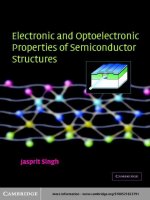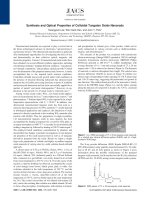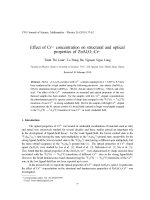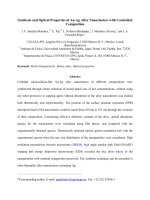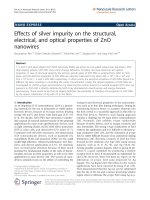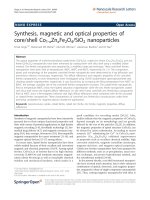Investigation of electronic and optical properties of molybdenum disulfide modulated by surface functionalization
Bạn đang xem bản rút gọn của tài liệu. Xem và tải ngay bản đầy đủ của tài liệu tại đây (9.25 MB, 141 trang )
INVESTIGATION OF ELECTRONIC AND OPTICAL
PROPERTIES OF MOLYBDENUM DISULFIDE
MODULATED BY SURFACE FUNCTIONALIZATION
LIN JIADAN
(B.Sc. SICHUAN UNIVERSITY)
A THESIS SUBMITTED
FOR THE DEGREE OF DOCTOR OF PHILOSOPHY
DEPARTMENT OF PHYSICS
NATIONAL UNIVERSITY OF SINGAPORE
(2014)
Declaration
I hereby declare that this thesis is my original work and it has been written by
me in its entirety. I have duly acknowledged all the sources of information
which have been used in the thesis.
This thesis has also not been submitted for any degree in any university
previously.
_______________ ___
LIN JIADAN
1 Aug 2014
ii
Dedicated to my beloved family, boyfriend and friends.
iii
Acknowledgement
I take this opportunity to express my gratitude to the people who have
been instrumental in the completion of this thesis.
Foremost, I would like to express the deepest appreciation to my
supervisor Prof. Chen Wei for his tremendous support and guidance. I am
grateful to him for his stimulating suggestions and encouragement. In spite of
his very busy schedule, he always gives me valuable and in-depth suggestions
on my projects, reviews all my manuscripts carefully and offers detailed
comments. What impressed me most is his enthusiasm, encouragement and
faith in me throughout. Without his guidance, mentoring, persistent help and
extensive knowledge, this thesis would not have been possible.
I also would like to thank other group members in the surface and
interface laboratory, Dr. Xie Lanfei, Mr. Han Cheng, Dr. Wang Yuzhang, Dr.
Niu Tianchao, Dr. Wei Dacheng, Dr. Pan Feng, Dr. Zhang Jialin, Ms. Zhong
Shu, Mr. Zhong Jianqiang, Dr. Mao Hongying, Mr. Wang Rui, Dr. Liu Yiyang,
Dr. Rao Richuan and so many others, for their help and fruitful discussions
during my experiments, for many happy days we spend together.
I am also indebted to Dr. Li Hai from Nanyang Technological University,
Dr. Lu JunPeng, Dr. Zheng Minrui, Dr. Hu Zhibin from Nanomaterials
Research Lab, Dr. Jun You from Graphene Research Center, Mr. Zeng
Shengwei, Dr. Wang Xiao from NanoCore, Dr. Mr. Han Sanyang from
Chemistry Department, for supporting me during my study, for training me to
use their equipments, for much fun working together.
iv
My sincere thanks to Prof. Andrew T. S. Wee, Prof. Zhang Hua, Prof.
SOW Chorng Haur for their revision of my manuscript and allowing me to
conduct experiment in their lab.
The financial support from the National University of Singapore is
gratefully acknowledged.
Last but not the least I place a deep sense of gratitude to my family for
loving, caring, and believing in me. Their love and guidance has better
prepared me to face challenges in the future. Finally, special thanks to my
loving and supportive boyfriend Mr. Di Kai, who has been a constant source
of inspiration during my study. His tender love, companionship are
appreciated throughout all the seasons of life.
v
List of Publications
1. “Plasmonic enhancement of photocurrent in MoS
2
field-effect-transistor”
Lin JD, Li H, Zhang H, Chen Wei*, Appl. Phys. Lett. 102, 203109 (2013)
2. “Modulating electronic transport properties of MoS
2
field effect transistor
by surface overlayers”
Lin JD, Zhong JQ, Zhong S, Li H, Zhang H, Chen Wei*, Appl. Phys. Lett.
103, 063109 (2013)
3. “Electron-Doping-Enhanced Trion Formation in Monolayer Molybdenum
Disulfide Functionalized with Cesium Carbonate”
Lin JD, Han C, Wang F, Wang R, Xiang D, Qin SQ, Zhang XA,Wang L,
Zhang H, Wee ATS, Chen Wei*, ACS Nano 8, 5323 (2014)
4. “Manipulating the Electronic Properties of Graphene via Molecular
Functionalization” (invited review article) Mao HY, Lu YH, Lin JD,
Zhong S, Wee ATS, Chen Wei*, Prog. Surf. Sci. 88, 132-159 (2013)
5. “High work function anode interfacial layer via mild temperature thermal
decomposition of C
60
F
36
thin film on ITO”
Mao HY, Wang R, Zhong JQ, Zhong S, Lin JD, Wang XZ, Chen ZK,
Chen Wei*, J. Mater. Chem. C., 1, 1491-1499 (2013)
6. “Ionization Potential Dependent Air Exposure Effect on the MoO
3
/Organic
Interface Electronic Structures”
Zhong JQ, Mao HY, Wang R, Lin JD, Zhao YB, Zhang JL, Ma DG, Chen
Wei* Organic Electronics 12, 2793-2800 (2012).
7. “The Role of Gap States on the Energy Level Alignment at the Organic
Heterojunction Interfaces” (invited review article)
Zhong S, Zhong JQ, Mao HY, Zhang JL, Lin JD, Chen Wei*, Phys.
Chem. Chem. Phys., 14, 14127-14141 (2012).
vi
8. “Improving chemical vapor deposition graphene conductivity using
molybdenum trioxide: An in-situ field effect transistor study ”
Han C, Lin JD, Xiang D, Wang CC, Wang L and Wei Chen*, Appl. Phys.
Lett. 103, 263117 (2013)
9. “Improved Photoelectrical Properties of MoS
2
Films after Laser
Micromachining”
Lu JP, Lu JH, Liu HW, Liu B, Chan XK, Lin JD, Chen W, Loh KP, Sow
Chorng Haur* ACS Nano 8, 6334 (2014)
10. “Ultrathin MnO
2
Nanoflakes as an Efficient Catalyst for Oxygen
Reduction Reaction”
Wei C; Yu LH; Cui CL; Lin JD; Chen W; Mathews, N; Huo FW; Sritharan,
T; Xu, Z* Chem. Commun 50, 7885 (2014)
vii
Table of Contents
Declaration i
Acknowledgement iii
List of Publications v
Table of Contents vii
Summary x
List of Tables xii
List of Figures xiii
List of Abbreviations xxii
Chapter 1 Introduction 1
1.1 2D TMDCs: background and literature review 2
1.1.1 Synthesis of 2D TMDCs 2
1.1.2 Electronic, optical and vibrational properties of TMDCs 5
Electronic structure 5
Optical properties 7
1.1.3 Device applications for 2D TMDCs 13
2D TMDCs FET 13
Optoelectronics 22
1.1.4 Surface functionalization of 2D TMDCs 30
Substitutional doping 30
Charge transfer doping (Surface functionalization) 32
1.2 Objective and scope of this thesis 39
Chapter 2 Experimental techniques 41
2.1 Preparation of MoS
2
41
2.2 Experimental techniques for device fabrication and measurements. 42
2.2.1 Electron beam lithography 42
2.2.2 Electrical measurement 46
2.2.3 Optoelectronic measurement 47
2.3 Experimental techniques for spectroscopic studies 48
2.3.1 Ultraviolet and X-ray photoemission spectroscopy 48
viii
2.3.2 Raman spectroscopy and photoluminescence spectroscopy 52
Chapter 3 Modulating MoS
2
electrical transport and optical properties by
surface overlayers 54
3.1 Introduction 54
3.2 Experiments details 56
3.3 Modulating MoS
2
FET electronic transport properties by C
60
57
3.4 Modulating MoS
2
electrical transport and optical properties by MoO
3
. 61
3.5 Conclusion 66
Chapter 4 Electron-Doping Enhanced Trion Formation in Monolayer
Molybdenum Disulfide Functionalized with Cesium Carbonate 67
4.1 Introduction 67
4.2 sample preparation and device fabrication 69
4.3 Modulating MoS
2
FET electronic transport properties by Cs
2
CO
3
surface
functionalization 71
4.4 Modulating optical properties of MoS
2
by Cs
2
CO
3
surface
functionalization 76
4.5 Air stability evaluation of Cs
2
CO
3
doping effect 78
4.6 Conclusion 81
Chapter 5 Plasmonic enhancement of photocurrent in MoS
2
field-effect-
transistor 82
5.1 Introduction 82
5.2 Experiments details 83
5.3 Photocurrent measurements of MoS2 FET with Au NPs. 84
5.4 Simulations on Enhanced Light Intensity by Surface Plasma in Au
Sphere 89
5.5 Conclusion 91
Chapter 6 Probing the interfacial interaction between monolayer MoS
2
and Au nanoclusters 92
6.1 Introduction 92
6.2 Device fabrication 93
6.3 Investigate the initial growth mode of Au on MoS
2
and its effect on
transport properties of MoS
2
FET 95
6.4 Probing the MoS
2
/Au interface interaction and the effect of Au
deposition on the optical properties of MoS
2
underneath 99
6.5 Conclusion 104
ix
Chapter 7 Conclusions and outlook 105
7.1 Thesis summary 105
7.2 Future work 108
Bibliography 110
x
Summary
This thesis aims to investigate the effect of surface functionalization on
the properties of two-dimensional (2D) transition metal dichalcogenides
(TMDCs), with particular emphasis on molybdenum disulfide (MoS
2
), a
representative member of 2D TMDCs family. Both electrical and optical
properties are characterized by complementary methods, including in-situ
bottom-gated MoS
2
field-effect transistors (FETs) device characterization, in-
situ ultraviolet photoelectron spectroscopy/X-ray photoelectron spectroscopy
(UPS/XPS) measurements, and Raman/photoluminescence (PL)
measurements, together with various state-of-the-art surface analysis
techniques
. We aim to investigate unique electronic and optical properties of
surface-modified MoS
2
and to further extend its potential applications.
We begin with an investigation of the effects of C
60
, molybdenum
trioxide (MoO
3
), cesium carbonate (Cs
2
CO
3
) on the modulation of MoS
2
properties through the combination of in-situ bottom-gated MoS
2
FETs device
characterization and in-situ UPS and XPS measurements. It is found that
negligible charge transfer takes place at the C
60
/MoS
2
interface, making C
60
as
good surface protection layer for MoS
2
FET devices. In contrast, the MoO
3
decoration layer depletes the electron charge carriers in MoS
2
, and hence
greatly modulates the transport properties and boosts the photoluminescence
of MoS
2
. We also found that the electron charge carrier concentration
increases dramatically due to the decoration by Cs
2
CO
3
. The dopant electrons
strongly interact with photoexcited electron-hole pairs, leading to the
emergence of trions and the reduction of photoluminescence. Air exposure
xi
experiment shows that the n-type doping effect by Cs
2
CO
3
has good air
stability, which is crucial for the practical applications of MoS
2
-based devices.
Our results suggest that chemical doping via surface functionalization has
great advantages in controlling the electronic and photoluminescence
properties of single layer MoS
2
.
Plasmonic metal nanostructures can be functionalized on 2D materials to
further manipulate the optical and electronic properties. We demonstrate that,
by combining MoS
2
with plasmonic gold nanoparticles (Au NPs), the
photocurrent of MoS
2
based phototransistor can be largely enhanced. The
wavelength-dependent photocurrent enhancement in MoS
2
device is caused by
the localized surface plasmon in Au NPs, which gives rise to the enhancement
of local optical field and thus resonant light absorption of the underlying MoS
2
layer. Au plasmonic nanostructures can also be directly fabricated on the
MoS
2
via e-beam lithography techniques. In this case, a direct physical contact
between Au and MoS
2
is established. Here, we also systematically investigate
the effect of the Au/MoS
2
interface formation on the electronic and electrical
transport properties of MoS
2
through the combination of in-situ FET
characterization and in-situ UPS/XPS measurements. We found that Au atoms
aggregate and form nanoclusters with average diameter of 25 nm on MoS
2
and
weakly interact with the underlying single layer MoS
2
, without any obvious
interfacial chemical intereactions. Our systematic study of the interface
properties between Au nanoclusters and MoS
2
should have important
implications for MoS
2
-based hybrid devices.
xii
List of Tables
Table 4.1 Air exposure test for MoS
2
transistor with 8.7 nm Cs
2
CO
3
on top 79
Table 5.1 Charge carrier mobility and electron concentration for MoS
2
transistor. 86
xiii
List of Figures
Figure 1.1 (a) Schematic illustration for the experimental set-up of CVD
process to grow MoS
2
. (b) The optical microscopy images of the MoS
2
layers
grown on the substrate. (c) Schematic illustration of the two-step thermolysis
process for the synthesis of MoS
2
thin layers on insulating substrates. The
precursor (NH
4
)
2
MoS
4
was dipcoated on SiO
2
/Si or sapphire substrates
followed by the two-step annealing process. The as-grown MoS
2
film can be
transferred onto other arbitrary substrates. (d) Schematic representation of the
experimental setup used for the synthesis of WS
2
films involving high
temperature treatments under a sulfur/argon environment at low pressure (450
mTorr). (e) Photograph of a WS
2
film on a SiO
2
/Si substrate, exhibiting the
high optical contrast and color change (films appear in a cyan color upon
contrast with the SiO
2
substrate). (a) and (b) reprinted from ref. 35, with
permission from WILEY-VCH Verlag GmbH & Co. KGaA, Weinheim,
Copyright 2012; (c) reprinted from ref. 34, with permission from American
Chemical Society, Copyright 2012; (d) and (e) reprinted from ref. 36, with
permission from American Chemical Society, Copyright 2013. 3
Figure 1.2 (a) Side and top view of crystal structure of MX
2
. (b)-(e)
Calculated electronic band structures of bulk MoS
2
, MoSe
2
, WSe
2
and WS
2
,
respectively. (f)-(i) Calculated electronic band structures of monolayer MoS
2
,
MoSe
2
, WSe
2
and WS
2
, respectively. (j)-(m) Second-derivative ARPES
spectra of monolayer, bilayer, trilayer and 8 ML MoSe
2
thin films along the
Γ–K direction. Yellow dashed lines indicate the Fermi levels. (a)-(i) reprinted
from ref. 46, with permission from EDP Sciences, SIF, Springer-Verlag Berlin
Heidelberg, Copyright 2012; (j)-(m) reprinted from ref. 40, with permission
from Nature Publishing Group,Copyright 2013. 7
Figure 1.3 (a) PL spectra for monolayer and bilayer MoS
2
samples in the
photon energy range from 1.3 to 2.2 eV. Inset left: PL QY of thin layer for N=
1-6. Inset right: Representative optical image of mono-and few-layer MoS
2
crystals on a silicon substrate with etched holes of 1.0 and 1.5 µm in diameter.
(b) PL spectra of monolayer and few-layer MoSe
2
. (c) PL spectra of
monolayer and few-layer WSe
2
. (d) PL intensities for 1L, 2L, 3L, and bulk
WS
2
using the 488nm excitation laser line. The positions for the excitons A
and B as well as the indirect band gap (I) are labeled. (a) reprinted from ref.17,
with permission from the American Physical Society, Copyright 2010; (b)-(d)
reprinted from ref 56, with permission from OSA. 9
xiv
Figure 1.4 (a) PL spectra of the transferred MoS
2
on SiO
2
/Si substrate and
mica. The PL intensity of the B excitonic peak is 5-fold amplified for clarity.
(b) and (c) Excitons and trions at room temperature in monolayer MoS
2
. (b)
Photoluminescence spectra at different back-gate voltages. Both the neutral
exciton (A) and trion (A
-1
) features (with the corresponding resonance
energies indicated by the dashed lines) can be identified, although the
resonances are significantly broadened. Inset: representation of the
dissociation of a trion into an exciton and an electron at the Fermi level. (c)
Dependence on gate voltage of the drain–source current (right) and the
integrated photoluminescence intensity of the A and A
-1
features and their
total contribution (left). (d) Raman spectra of thin (nL) and bulk MoS
2
films.
The solid line for the 2L spectrum is a double Voigt fit through data (circles
for 2L, solid lines for the rest). (e) Raman spectra of bulk and few-layer
MoSe
2
. Labels ‘1L’ – ‘5L’ indicate the number of layers. Raman spectra are
vertically displaced for clarity. (a) reprinted from ref. 59, with permission
from American Chemical Society, Copyright 2013; (b) and (c) reprinted from
ref. 60, with permission from Nature Publishing Group, Copyright 2012; (d)
reprinted from ref. 37, with permission from American Chemical Society,
Copyright 2010; (e) reprinted from ref. 56, with permission from OSA. 12
Figure 1.5 (a) Local gate control of the MoS
2
monolayer transistor. I
ds
–V
tg
curve recorded for a bias voltage ranging from 10 mV to 500 mV.
Measurements are performed at room temperature with the back gate
grounded. Top gate width = 4 mm; top gate length = 500 nm. The device can
be completely turned off by changing the top gate bias from –2 to –4 V. For
V
ds
= 10 mV, the I
on
/I
off
ratio is 1× 10
6
. For V
ds
= 500 mV, the I
on
/I
off
ratio is
1× 10
8
in the measured range while the subthreshold swing S = 74 mV/decade.
Inset: Cross-sectional view of the structure of a monolayer MoS
2
FET together
with electrical connections used to characterize the device. A single layer of
MoS
2
(thickness, 6.5 Å) is deposited on a degenerately doped silicon substrate
with 270-nm-thick SiO
2
. The substrate acts a back gate. One of the gold
electrodes acts as drain and the other source electrode is grounded. The
monolayer is separated from the top gate by 30 nm of ALD-grown HfO
2
. The
top gate width for the device is 4 mm and the top gate length, source–gate and
gate–drain spacing are each 500 nm. (b) Transport characteristics of 10 nm
thin MoS
2
back-gated transistors with Sc, Ti, Ni, and Pt metal contacts at 300
K for V
DS
= 0.2 V. The inset shows the output characteristics of the
corresponding devices for a gate voltage overdrive of 4.0−5.0 V. (c) The inset
shows the actual line-up of metal Fermi level with the electronic bands of
MoS
2
flake based on the experimental data. (d) Schematic illustration of the
working principle of an ionic-liquid-gated MoS
2
FET. (e) Transport
characteristics of representative bilayer and trilayerMoS
2
ionic-liquid-gated
FETs measured at the drain-source bias V
ds
= 1 V. (f) Optical microscope
xv
image of a six-terminal Hall bar fabricated on a crystalline WS
2
thin flake (the
scale bar is 10 μm long), cross section of a WS
2
ionic liquid-gated FET and
transport characteristic of a WS
2
ionic liquid-gated FET measured at V
D
= 0.1
V as a function of gate voltage V
G
(sweep rate 10 mV/s). (a) reprinted from ref.
75, with permission from Nature Publishing Group, Copyright 2011; (b) and
(c) reprinted from ref. 79, with permission from American Chemical Society,
Copyright 2012; (d) and (e) reprinted from ref. 92, with permission from
American Chemical Society, Copyright 2013; (f) reprinted from ref. 93, with
permission from American Chemical Society, Copyright 2012. 19
Figure 1.6 (a) Characteristics of the integrated MoS
2
inverter. Output voltage
as a function of the input voltage. Schematic drawing of the electronic circuit
and the truth table for the NOT logic operation (inset). (b) Schematic
illustration of an integrated five-stage ring oscillator circuit on MoS
2
thin films,
which is constructed by integrating 12 MoS
2
FETs. Three distinct metal layers
of the MoS
2
IC are represented by M1,M2, and M3. M1 is directly in contact
with the bilayer MoS
2
thin film while M2 and M3 are the Pd and Al gate
layers, respectively. Via holes are etched through the HfO
2
dielectric layer to
allow connections from M2 and M3 to M1. The fabricated ring oscillator
circuit corresponding to the design above is shown in (d). (c) Optical
micrograph of the NAND gate and the SRAM fabricated on the same bilayer
MoS
2
thin film. The corresponding schematics of the electronic circuits for the
NAND gate and SRAM are also shown. (d) Optical micrograph of the ring
oscillator constructed on a bilayer MoS
2
thin film. (a) reprinted from ref. 95,
with permission from American Chemical Society, Copyright 2011; (b)-(d)
reprinted from ref. 96 , with permission from American Chemical Society,
Copyright 2012. 21
Figure 1.7 (a) Photoswitching rate of photoswitching behavior of single-layer
MoS
2
phototransistor at V
ds
= 1 V, P
light
= 80 μW. (b) Dependence of
photoresponsivity on the gate voltage (V
ds
= 1 V, P
ligh
t = 80 μW). (c)
Photoresponsivity of the MoS
2
phototransistor, showing high sensitivity. The
device exhibits a photoresponsivity of 880 AW
-1
for an illumination power of
150 pW (~24 µWcm
-2
) and shows a monotonous decrease with increasing
illumination intensity due to the saturation of trap states present either in MoS
2
or at the MoS
2
/substrate interface. Inset: Three-dimensional schematic view of
the single-layer MoS
2
photodetector and the focused laser beam used to probe
the device. (d) Band diagram of the monolayer MoS
2
photodetector taking into
consideration small Schottky barriers at the contacts. E
F
is the Fermi level
energy, E
C
the minimum conduction band energy, E
V
the maximum valence
band energy and F
B
the Schottky barrier height. There is no electrical current
flowing under equilibrium conditions and no illumination. Photocurrent is
generated under illumination and is the dominant channel current in the OFF
xvi
state, with thermionic and tunnelling currents being negligible. Thermionic
and tunnelling currents contribute in the ON-state of the device. (a) and (b)
reprinted from ref. 73, with permission from American Chemical Society,
Copyright 2012; (c) and (d) reprinted from ref 110, with permission with by
Nature Publishing Group, Copyright 2013. 25
Figure 1.8 (a-b) Schematic of the photoresponse mechanism in a device
dominated by photo-thermoelectric effect. The conduction band is drawn in
blue while the valence band is drawn in red. (c) Optical microscopic top-view
image of the few-layer MoS
2
MSM PDs. (d) High-resolution time response of
MoS
2
PDs measured at 5-V bias with I
light
= 2.0 × 10
4
W/m
2
. (e) Photogain
and responsivity as a function of wavelength measured under a bias of 10 V.
(a) and (b) reprinted from ref. 104, with permission from American Chemical
Society, Copyright 2013; (c)-(e) reprinted from ref. 115, with permission from
American Chemical Society, Copyright 2013. 27
Figure 1.9 (a) Absorbance of three TMD monolayers and graphene,
overlapped to the incident AM1.5G solar flux. (b) The external quantum
efficiency of graphene/WS
2
/graphene heterostructures is the ratio of the
number of measured e-h pairs to the number of incident photons. Due to the
small variation in optical absorption across this wavelength range, the data for
different wavelengths collapse onto a single curve. Inset: Photocurrent
measured with a 1.95-eV laser as a function of intensity. (c) Schematic
illustration of the side view of the vertical heterostructures of graphene–
MoS
2
–graphene device, with the semiconducting multilayer MoS
2
sandwiched
between the Gr
T
and Gr
B
electrodes. Red and blue colours indicate electrons
and holes, respectively. The silicon substrate can be used as a back-gate
electrode with 300nm SiO
2
as the dielectric layer. (d) Experimental current–
voltage characteristic of the vertical device in the dark (blue) and under
illumination (red) by a focused laser beam (wavelength, 514 nm; power, 80
mW; spot size, 1 mm). (a) reprinted from ref. 121, with permission from
American Chemical Society, Copyright 2013; (b) reprinted from ref. 119, with
permission from The American Association for the Advancement of Science,
Copyright 2013; (c) and (d) reprinted from ref. 120, with permission from
Nature Publishing Group, Copyright 2013. 29
Figure 1.10 (a) Schematic of Nb-doping in CVD grown MoS
2
. (b)
Temperature dependent Hall measurement on degenerately Nb-doped MoS
2
sample (p=1.5 × 10
21
cm
-3
) showing no carrier freeze-out at 20 K. (c)–(e)
Series of AC HR-TEM images demonstrating vacancy filling in MoS
2
. The
left arrow (red) highlights an initial S vacancy that picks up an atom between
(d) and (e), and the right arrow (green) indicates a S atom that is sputtered
away between (c) and (d), forming a single vacancy. (f) Illustration of the
xvii
electrical measurement setup of a back-gated MoS
2
rectifying diode with
selected area treated with plasma. (g) Semi-logarithmic plots of I
DS
-V
DS
characteristic curves (V
G
= 0V) of a SF
6
-treated diode, which were measured 0
(dashed line) and 30 (solid line) days after the device fabrication. (a) and (b)
reprinted from ref. 130, with permission from AIP Publishing LLC, Copyright
2014; (b)-(e) reprinted from ref. 131, with permission from American Physical
Society, Copyright 2012; (f) and (g) reprinted from ref. 132, with permission
from AIP Publishing LLC, Copyright 2013. 32
Figure 1.11 (a) Change in PL of MoS
2
(from its annealed but measured in
vacuum value) upon exposure to H
2
O alone, O
2
alone, and ambient air. Trion
X
−
and exciton X
0
peak positions are indicated. (b) PL spectra of 1L-MoS
2
before and after being doped with p-type molecules (TCNQ and F
4
TCNQ). (c)
PL spectra of 1L-MoS
2
before and after being doped with an n-type dopant
(NADH). (a) reprinted from ref. 139, with permission from American
Chemical Society, Copyright 2013; (b) and (c) reprinted from ref. 140, with
permission from American Chemical Society, Copyright 2013. 35
Figure 1.12 (a) I
ds
vs V
ds
characteristics for a representative MoS
2
PFET with
MoO
x
contacts. (b) I
ds
vs V
gs
characteristics for WSe
2
devices contacted with
MoO
x
and Pd alone. (c) Temperature-dependent I
d
vs V
sd
electrical
characteristics of the diode. Insets: Schematic of related devices. Reprinted
from ref. 141, with permission from American Chemical Society, Copyright
2014 36
Figure 1.13 (a) Schematic of a top-gated WSe
2
ML-FET with chemically p-
doped S/D contacts by NO
2
exposure. Here the top-gate acts as the mask for
protecting the active channel from NO
2
doping. (b) Transport characteristics
of a device with L of ∼9.4 µm before and after NO
2
patterned doping of the
S/D contacts. (c) Schematic of a top-gated few-layer MoS
2
n-FET with
chemically n-doped S/D contacts by K exposure. (d) Output characteristics of
a device (thickness of three layers, L ∼ 1 μm) before K doping at a back gate
voltage of 0 V. (e) Schematic of a top-gated few-layer WSe
2
n-FET, with
chemically n-doped S/D contacts by K exposure. (f) Transport characteristics
of a 3-layer WSe
2
device (L ∼ 6.2 μm) as a function of K exposure time. The
black curve is measured before doping, while the other curves from bottom to
top after respective 1, 20, 40, 70, and 120 min doping. (g) Schematic of the
WSe
2
CMOS inverter, depicting the n- and p-FET components. (h) Voltage
transport characteristics of a WSe
2
CMOS inverter at different supply voltages.
(a) and (b) reprinted from ref. 142, with permission from, American Chemical
Society, Copyright 2012; (c)-(f) reprinted from ref. 143, with permission from
American Chemical Society, Copyright 2013; (g) and (h) reprinted from ref.
144, with permission from American Chemical Society, Copyright 2014. 38
xviii
Figure 2.1 Optical contrast of exfoliated MoS
2
with different layers on 300nm
SiO
2
/Si substrate. 42
Figure 2.2 Schematic process flow diagrams for standard e-beam lithography
for device fabrication. 43
Figure 2.3 Photograph of Nova NanoSEM 230 scanning electron microscope
system and schematic of typical EBL system
150-152
. 45
Figure 2.4 Typical steps of the MoS
2
-based device fabrication process. 45
Figure 2.5 (a) Photograph
154
and (b) schematic of our home-made in-situ
electrical characterization system. 47
Figure 2.6 (a-c) photographs
154
and (d) Schematic of our optoelectronic
measurement system. 48
Figure 2.7 Example of a typical PES spectrum showing the various energy
levels. The inset displays the schematic of photoelectron emission process in a
PES experiment. 50
Figure 2.8 Photography of the multi-chamber UHV system for PES
experiments. 52
Figure 2.9 different types of light scattering: Rayleigh scattering, Stokes
Raman scattering and anti-Stokes Raman scattering. 53
Figure 3.1 (a) The structure of a buckminsterfullerene
185
and (b) Crystal
structure of orthorhombic MoO
3
showing the layered structure along the (010)
direction. 55
Figure 3.2 (a) Schematic illustration of the MoS
2
FET layout with C
60
or
MoO
3
film on top. (b) Optical microscope image of single-layer MoS
2
flakes.
(c) Optical microscope image of the fabricated device. 57
Figure 3.3 (a) Transport characteristic (I-V
g
) of the monolayer MoS
2
FET in
log scale, where V
ds
= 40 mV. (b) Transport characteristics of the same device
in high vacuum with increasing thickness of C
60
overlayers. (In linear scale).
Inset: schematic illustration of deposition of C
60
on the MoS
2
FET in vacuum.
(c) UPS spectra at the low-kinetic energy region (secondary electron cut-off)
during the deposition of C
60
on bulk MoS
2
. (d) Energy level diagram at the
MoS
2
/C
60
interface. 60
xix
Figure 3.4 Mo3d (a), S2p (b) and C1s (c) core level spectra during the
deposition of C
60
on top of MoS
2
crystal. 61
Figure 3.5 (a) Transport characteristics (I-V
g
) for back-gated few-layer MoS
2
transistor before and after 0.1 nm MoO
3
deposition in vacuum. (b) The sample
work function and S 2p of MoS
2
as a function of the MoO
3
thickness. (c)
Energy level diagram for MoS
2
/MoO
3
. The XPS core level spectra of (d) S 2p
and (e) Mo 3d during the deposition of MoO
3
on bulk MoS
2
. 63
Figure 3.6 (a) PL and (b) Raman spectra of 1L-MoS
2
before and after MoO
3
doping (2 steps) at room temperature. Step 1: ~ 0.1 nm; step 2: ~2 nm. 65
Figure 4.1 (a) Optical microscope image of the single-layer MoS
2
on a 300
nm SiO
2
/Si substrate (scale bar = 10 μm). (b) Raman spectrum of single- layer
MoS
2
on 300 nm SiO
2
/Si substrate. 70
Figure 4.2 (a) Schematic illustration of the MoS
2
FET layout with Cs
2
CO
3
film on top. (b) Optical microscope image of one fabricated device. (c)
Transport characteristic (I
ds
-V
g
) of the MoS
2
FET, where V
ds
= 100 mV. Inset:
output curve (I
ds
-V
ds
) acquired for V
g
value of 40 V. 71
Figure 4.3 (a) Transport characteristics of the same MoS
2
FET in high
vacuum with increasing thickness of Cs
2
CO
3
overlayers. (V
ds
= 100 mV) (b)
Estimated field effect mobility and electron concentration at V
g
= 0 V as a
function of the Cs
2
CO
3
film thickness. 73
Figure 4.4 (a) - (c) UPS spectra at (a) the low kinetic energy (secondary
electron cut-off) and (b) and (c) low binding energy region (near the E
f
) during
the deposition of Cs
2
CO
3
on bulk MoS
2
. The XPS core level spectra of (d) S
2p and (e) Mo 3d during the deposition of Cs
2
CO
3
on bulk MoS
2
. 75
Figure 4.5 (a) PL and (b) Raman spectra of 1L-MoS
2
before and after Cs
2
CO
3
(0.7 nm) doping at room temperature. 77
Figure 4.6 (a) Typical transport curves (I
ds
-V
g
) for the same device under light
illumination and dark without and with Cs
2
CO
3
decoration. (b) Photocurrent of
the device as function of time of the illumination source at constant optical
power without (orange line) and with (violet line) Cs
2
CO
3
, respectively. (V
ds
:
20mV, V
g
: 0 V) 78
Figure 4.7 Transport characteristics of both bottom-gated MoS
2
FETs with 7
nm Cs
2
CO
3
and the pristine MoS
2
FET before and after air exposure. 80
Figure 4.8 Transport characteristics of both bottom-gated MoS
2
FETs with 7
nm Cs
2
CO
3
exposed in air immediately (a) and exposed in air for 3 days (b),
compared to the pristine MoS
2
FETs tested in vacuum. 80
xx
Figure 5.1 (a) Three-dimensional schematic view of the MoS
2
transistor. (b)
Optical image of MoS
2
(4 to 5 layers) deposited on top of 300 nm SiO
2
/Si
substrate. Scale bar, 20 μm. (c) Scanning electron microscopy image of Au
nanoparticles on MoS
2
surface. Scale bar, 100 nm. Inset: Scale bar, 5 μm. 84
Figure 5.2 (a) Transport characteristics (I-V
g
) for the back-gated MoS
2
transistor. Inset: I
ds
– V
ds
curves acquired for V
bg
values of 80, 60, 40, 20 and
0 V. (b) Typical transpor curves (I-V
g
) for the same device under light
illumination and dark. (c) Transport characteristics (I-V
g
) for the same MoS
2
transistor with Au nanoparticles deposited on top. (d) Typical transport curves
(I-V
g
) for the same device under light illumination and dark with Au
nanoparticles deposited on top. 87
Figure 5.3 (a) A comparison of the outputs of device under 514 nm light
illumination without and with Au NPs in small gate voltage range (< 20 V). (b)
and (c) Photocurrent of the device as a function of excitation wavelength of
the illumination source at constant optical power without and with Au
particles, respectively. (SD Voltage: 200 mV, G Voltage: 20 V) (d)
Ultraviolet-visible (UV-vis) spectra of Au nano-particles in solution. Inset: A
transmission electron microscopy (TEM) image of Au nano-particles (15 nm).
Scale bar: 50 nm 89
Figure 5.4 Cross-section view of the norm of the E-field distribution (color-
coded). 90
Figure 5.5 E-field enhancement as a function of wavelength. The peak is
possibly due to surface plasma resonance. 90
Figure 6.1 (a) Schematic cross section a single layer MoS
2
FET. The channel
is MoS
2
with Cr/Au as electrode contact. Au nanoclusters were thermal
deposition on a MoS
2
FET device from an effusion cell. (b) and (c) Optical
images showing the prepared MoS
2
flakes and the fabricated MoS
2
FET
device. Scale bars: 10 µm. 94
Figure 6.2 AFM height images of prepared MoS
2
on SiO
2
/Si substrate with
Au nanoclusters deposited on top. The scanning area is (a) 10 µm, (b) 2 µm,
(c) 500 nm. The square frame in figure (a) refers to the scanning zoom of
figure (b). 96
Figure 6.3 (a) Transport characteristics of the MoS
2
FET in high vacuum with
increasing thickness of Au nanoclusters. (V
ds
= 50 mV) (b) Estimated field
xxi
effect mobility and electron concentration at V
g
= 40 V as a function of the Au
Nanoclusters thickness. 98
Figure 6.4 (a) - (c) UPS spectra at (a) the low kinetic energy (secondary
electron cut-off) and (b) and (c) low binding energy region (near the E
f
) during
the deposition of Au on bulk MoS
2
100
Figure 6.5 The XPS core level spectra of (a) Au 4f, (b) S 2p and (c) Mo 3d
during the deposition of Au on bulk MoS
2
. 101
Figure 6.6 (a) PL and (b) Raman spectra of 1L-MoS
2
before and after Au
nanoclusters decoration at room temperature. 103
xxii
List of Abbreviations
2D Two-Dimensional
TMDCs Transition Metal Dichalcogenides
MoS
2
Molybdenum Disulfide
FETs Field-Effect Transistors
UPS Ultraviolet Photoelectron Spectroscopy
XPS X-ray Photoelectron Spectroscopy
PL Photoluminescence
MoO
3
Molybdenum Trioxide
Cs
2
CO
3
Cesium carbonate
Au Gold
NPs Nanoparticles
CVD Chemical Vapour Deposition
S Sulfur
ARPES Angle-Resolved Photoemission Spectroscopy
MBE Molecular Beam Epitaxy
QY Quantum Yield
HfO
2
Hafnium Oxide
Al Aluminum
W Tungsten
Pt Platinum
Sc Scandium
xxiii
Ti Titanium
Ni Nickel
WF Work Functions
In Indium
PMMA Polymethyl Methacrylate
S Subthreshold Swing
SPCM Scanning Photocurrent Microscopy
MSM Metal-Semiconductor-Metal
PCE Power Conversion Efficiency
EQE Extrinsic Quantum Efficiency
Nb Niobium
PEI Polyethyleneimine
TTF Tetrathiafulvalene
TEA Triethylamine
SAM Self-Assembled Monolayers
SEM Scanning Electron Microscope
NPGS Nanometer Pattern Generation System
Cr Chromium
SMU Source/Measurement Unit
MBD Molecular Beam Deposition
QCM Quartz Crystal Microbalance
PES Photoemission Spectroscopy
SECO Secondary Electron Cut-Off
xxiv
HOMO Highest Occupied Molecular Orbital
EA Electron Affinity
IP Ionization Potential
AFM Atomic Force Microscopy
LUMO Lowest Unoccupied Molecular Orbital
OLEDs Organic Light-Emitting Devices
FEM Finite-Element-Method
